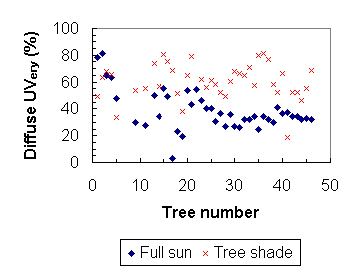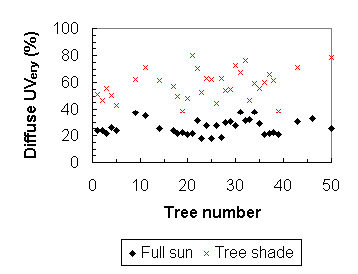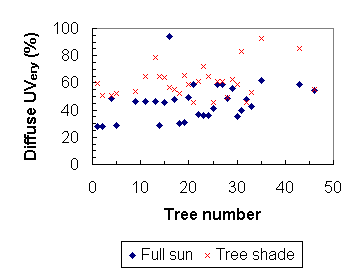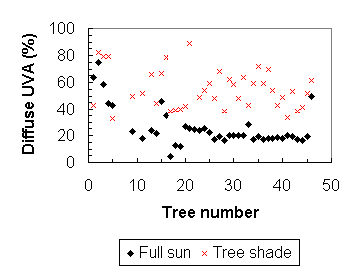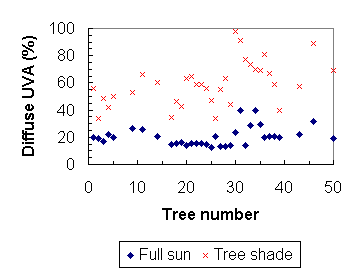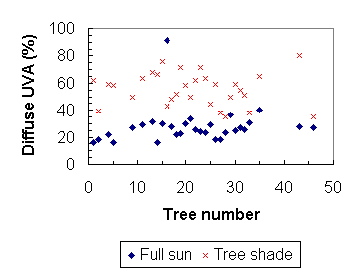| Papers and Posters | Site Home Page |
DIFFUSE COMPONENT OF THE SOLAR ULTRAVIOLET RADIATION IN TREE SHADE A.V. Parisi1,*, M.G. Kimlin1, J.C.F. Wong2, M. Wilson1
1Centre for Astronomy and Atmospheric Research, University of Southern Queensland, Toowoomba, 4350, Australia. Ph: 61 7 46 312226. Fax: 61 7 46 312721. Email: parisi@usq.edu.au
2Centre for Medical and Health Physics, Queensland University of Technology, GPO Box 2434, Brisbane 4001, Australia. Ph: 61 7 38642585. Fax: 61 7 38641521.
*To whom correspondence should be addressed
ABSTRACT
This paper has provided the first set of quantitative data of diffuse erythemal UV and
UVA in tree shade at a sub-tropical Southern Hemisphere latitude. Over the summer,
approximately 60% of the erythemal UV radiation in the tree shade is due to the diffuse
component. Similarly, approximately 56% of the UVA radiation in the tree shade is due to
the diffuse component. In the tree shade these diffuse UV percentages are relatively
constant from the morning to noon to afternoon periods. In comparison, in full sun, there
is a decrease in the percentage diffuse UV from morning to noon to afternoon. The
exposures to diffuse UV on a horizontal plane in the tree shade between 9:00 EST to 15:00
EST were of the order of 4 MED and 14 J cm-2 for erythemal UV and UVA
respectively. The high diffuse UV component in the shade may result in high UV exposures
to not only parts of the body on a horizontal plane that are not protected, but also,
equally high UV irradiances to parts of the body, including the eyes and face, that are
not UV protected.
1. INTRODUCTION
Personal UV exposure to humans is due to sunlight received as both direct radiation and
diffuse radiation. In full sun, the diffuse component is higher for larger solar zenith
angles for similar cloud conditions (Blumthaler et al., 1994). This diffuse radiation may
constitute a significant component to the UV exposure received by humans’ eyes and
skin as it is incident from all directions and difficult to minimise with the usage of
hats, tree shade and shade structures as it can reach surfaces shaded from the direct
component. Modelling of the diffuse solar irradiances has been previously described (for
example, Bird, 1984). Blumthaler and Ambach (1991) have measured the spectral global and
diffuse solar ultraviolet radiation. The diffuse UV to global radiation ratio increases
with decreasing wavelength due to the stronger Rayleigh scattering at the shorter
wavelengths. Ireland and Sacher (1996) have employed radiometers with narrow band
interference filters to measure the angular distribution of UV radiation at a Southern
Hemisphere site and Blumthaler et al., (1994) have measured the effects of clouds on the
diffuse UV irradiances.
This modelling and measurement by previous researchers of the diffuse UV irradiances has been in unshaded sunlight. The UV irradiances in tree shade have been measured (Parisi et al., 1999, Parsons et al., 1998 and Grant, 1997) and under crop canopies (Grant, 1991) and forest canopies (Flint and Caldwell, 1998). In tree shade, a larger proportion of the UV compared to that in full sun may be as a result of the diffuse component due to attenuation and filtering of the direct component. However, no previous research has considered the diffuse UV irradiances in tree shade. This paper presents the results of quantitative measurements of the diffuse erythemal and diffuse UVA (320 to 400 nm) at ground level on a horizontal plane during a Southern Hemisphere sub-tropical summer.
2. MATERIALS AND METHODS
2.1 Irradiance Measurements
The erythemal UV irradiance, UVery is defined as:
![]() (1)
(1)
where S(l) is the source UV spectrum, A(l)
is the erythemal action spectrum (CIE, 1987) and the integration is over the UV
wavelengths. The erythemal irradiances and the UVA irradiances were measured with a
radiometer (model 3D V2.0, Solar Light Co., Philadelphia, USA) fitted with an erythemal
sensor and a UVA sensor. Both the erythemal sensor and the UVA sensor were calibrated
against a calibrated dual holographic grating spectroradiometer with calibration traceable
to the National Measurement Laboratory (Wong et al., 1995). Additionally, for each
measurement of the erythemal and UVA irradiances, the visible irradiances were measured
with a LUX meter (model EMTEK LX-102, supplier, Walsh’s Co., Brisbane, Australia).
The ambient erythemal UV irradiances in full sun on a horizontal plane were continuously
monitored during daylight hours through the summer with a Biometer (model 501, Solar Light
Co., Philadelphia, USA) permanently mounted on an unobstructed building roof. The Biometer
was calibrated against the calibrated spectroradiometer.
The irradiance measurements were at ground level on a horizontal plane over a Southern Hemisphere summer in the tree shade on the side of the trunk furthermost from the sun between 1 December 1998 and 28 February 1999. The trees employed in the research were forty-two isolated trees in the grounds of the University of Southern Queensland campus, Toowoomba, Australia at a latitude of 27.5o S. The width of the tree canopies ranged from 2.2 to 13 m, the tree heights ranged from 6.4 to 25 m and the height above the ground to the first branches ranged from 0.4 to 10 m. The cloud cover varied between zero cloud and seven eights of the sky dome covered in cloud as determined by an observer. The cloud cover and atmospheric conditions vary with time and from day to day. The measurements over the summer were designed to take into account the typical cloud and other atmospheric conditions that would be encountered over a Southern Hemisphere summer.
2.2 Diffuse Irradiances
The diffuse UVery and UVA irradiances were measured by holding a shadow band
approximately 15 cm above the respective detector to shadow it. The irradiances were
measured approximately in the centre of the visible tree shade for the relevant tree. No
measurements were made if there was no shade visible due to cloud cover. The diffuse UV
radiation in both wavebands was also measured in full sunlight and at least 3 metres clear
of any shade. These measurements were as close as possible in time to the measurements in
the tree shade to minimise the effects of variations in solar zenith angle and atmospheric
conditions.
The diffuse irradiances were measured for each of the trees between 8:30 Australian Eastern Standard Time (EST) and 9:30 EST, 11:30 EST and 12:30 EST and 14:30 EST and 15:30 EST. For the remainder of this paper, these time periods are referred to as morning, noon and afternoon.
3. RESULTS
3.1 Diffuse UV
The diffuse erythemal UV irradiances as a percentage of the erythemal UV in the tree shade
are presented in Figure 1 for the morning, noon and afternoon. In comparison, the diffuse
erythemal UV irradiances as a percentage of the erythemal UV in full sun are also shown.
The percentage diffuse UVery irradiances in tree shade range from 19% to 82%,
39% to 80% and 45% to 92% for the morning, noon and afternoon respectively. Figure 2
provides the percentage of the UVA in the tree shade at the three time periods. The
variation in the percentages of diffuse UV in both the sun and the shade is most likely
due to the variation in the amount of cloud cover from zero cloud to seven eights cloud
over the summer of the measurements. In the shade, the additional contributing factor to
the variation is any contribution that differences in canopy density between trees may
make on the diffuse UV.
(a) |
|
(b) |
|
(c) |
|
Figure 1 – The percentage diffuse erythemal UV in the (a) morning, (b) noon and (c) afternoon.
(a) |
|
(b) |
|
(c) |
|
Figure 2 – The percentage diffuse UVA radiation in the (a) morning, (b) noon and
(c) afternoon.
For the majority of the cases, the percentage diffuse UVery and UVA are higher in the tree shade compared to the respective diffuse irradiance percentages in the full sun. At noon, there is a better defined separation between the diffuse erythemal UV in the tree shade compared to the diffuse erythemal UV in the full sun. In comparison, for the morning and afternoon, the diffuse erythemal UV in the full sun is in general higher with less difference between the diffuse UV in the tree shade and the full sun. This is most likely due to the higher atmospheric pathlength in the morning and afternoon resulting in higher percentage diffuse UV in the full sun.
In Figure 1 there are two data points in the morning and one data point in the afternoon with more than 70% diffuse erythemal UV in full sun. Similarly, in Figure 2 there is one data point in the morning and one data point in the afternoon with more than 70% diffuse UVA in full sun. These high diffuse irradiances in full sun were most likely due to the seven eights cloud at the time on these specific days. The percentage diffuse UVA in Figure 2 is different to the percentage diffuse UVery in Figure 1, possibly due to the differences in Rayleigh scattering for the two wavebands.
3.2 Average Diffuse UV
The absolute diffuse UVery and UVA irradiances on a horizontal plane at ground
level averaged over all of the trees in tree shade and in full sun are provided in Table 1
for the morning, noon and afternoon. The unit for the UVery irradiances is
MED/h, where an MED (minimum erythemal dose) is the amount of biologically effective UV
required to produce barely perceptible erythema after an interval of 8 to 24 hours
following UV exposure (Diffey, 1992). The error is one standard deviation of the
mean. The diffuse irradiances have been averaged over all of the trees measured over the
summer to take into account the atmospheric conditions encountered over the summer. The
diffuse irradiances in the tree shade may also be affected by the tree parameters such as
canopy density. However, the aim of this paper is to provide a general guide for the trees
employed in the project. The standard error in the diffuse UV radiation is less than 10%.
The diffuse UVery and UVA irradiances in the tree shade are higher at noon by 48% and 20% respectively compared to the average of the morning and afternoon irradiances, most likely due to the higher noon irradiances. Employing linear interpolation between the three measurement times provides an exposure due to the diffuse UV to a horizontal plane in tree shade of 4 MED and 14 J cm-2 between 9:00 EST and 15:00 EST for erythemal UV and UVA respectively. For comparison, the erythemal UV irradiances on a horizontal plane in full sun for a relatively cloud free day (4 December 1998) and a cloudy day (17 December 1998) are provided in Figure 3. The units are in MED/15 minutes as 15 minutes was the recording period of the datalogger on the Biometer. The erythemal irradiances summed between 9:00 EST and 15:00 EST are 29.1 MED and 25.4 MED for the cloud free and cloudy days respectively.
Table 1 – The diffuse UVery and UVA irradiances averaged over all of the trees in tree shade and in full sun.
| Waveband | Diffuse UV Radiation |
|||||
Tree Shade |
Full Sun |
|||||
morning |
noon |
afternoon |
Morning |
Noon |
afternoon |
|
| UVery (MED/h) | 0.56± 0.02 |
0.80± 0.06 |
0.52± 0.03 |
0.70± 0.03 |
0.90± 0.03 |
0.77± 0.04 |
| UVA (mW cm-2) | 0.61± 0.03 |
0.72± 0.06 |
0.59± 0.03 |
0.73± 0.04 |
0.82± 0.03 |
0.77± 0.03 |
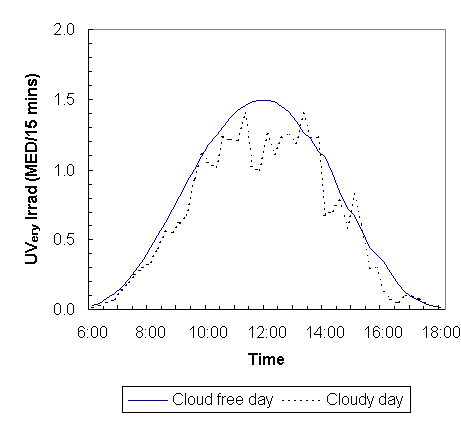
Figure 3 – Erythemal UV data for a relatively cloud free day and a cloudy day in summer.
The averages over all the trees of the percentage diffuse UV radiation in the tree shade compared to the UV in the tree shade and the percentage diffuse UV radiation in the full sun compared to the UV in full sun are provided in Table 2. Additionally, the percentage diffuse visible radiation in tree shade and full sun are provided for comparison. The error is one standard deviation of the mean.
For the summer measurements in this research, the percentage diffuse radiation of UVery in the tree shade is relatively constant at about 60% from the morning period to the afternoon period. In comparison, as expected due to the longer atmospheric pathlength causing additional scattering in the morning and afternoon, the percentage diffuse radiation in the full sun is higher in the morning and afternoon compared to that at noon. The differences between the visible waveband and the erythemal UV of the percentage diffuse radiation in the tree shade was approximately the same in the morning, noon and afternoon time periods. In comparison, the same difference in the full sun varies over the three periods.
Table 2 – Average over all the trees of the percentage diffuse UV and visible irradiances in tree shade and in full sun.
| Waveband | Percentage Diffuse Radiation (%) |
|||||
Tree Shade |
Full Sun |
|||||
morning |
noon |
afternoon |
Morning |
Noon |
afternoon |
|
| UVery | 60± 2 |
60± 2 |
61± 2 |
39± 2 |
26± 1 |
46± 3 |
| UVA | 54± 2 |
57± 3 |
56± 2 |
26± 2 |
20± 1 |
28± 2 |
| Visible | 53± 3 |
54± 3 |
54± 4 |
21± 4 |
14± 1 |
19± 3 |
DISCUSSION
Quantitative measurements and research on UV radiation in different environments and
settings is vital in developing and assessing UV preventative strategies for the reduction
of skin cancer and other UV related problems for humans. This paper has provided the first
set of quantitative data of diffuse erythemal UV and UVA in tree shade at a sub-tropical
Southern Hemisphere latitude. Over the summer, approximately 60% of the erythemal UV
radiation in the tree shade is due to the diffuse component. Similarly, approximately 56%
of the UVA radiation in the tree shade is due to the diffuse component. The standard error
in the set of measurements is less than 10%. These values approach the percentage diffuse
UV component in full sun for winter. However, in the tree shade they are relatively
constant from the morning to noon to afternoon periods. In comparison, there is a decrease
in the percentage diffuse UV in full sun at noon compared to the morning and afternoon.
For the erythemal UV, the decrease is from approximately 40% in the morning and afternoon
to 26% at noon. The tree shade has increased the diffuse component in summer from 26% to
60% at noon and from approximately 40% in the morning and afternoon to 60%.
This high percentage of diffuse radiation has a consequence that the UV protective capability of hats for the relatively high UV irradiances in tree shade (Parisi et al., 1999, Parsons et al., 1998), while useful, is not as high as in full sun. The exposures to diffuse UV on a horizontal plane in the tree shade between 9:00 EST to 15:00 EST were of the order of 4 MED and 14 J cm-2 for erythemal UV and UVA respectively. This high diffuse UV component in the shade may result in high UV exposures to not only parts of the body on a horizontal plane that are not protected, but also, equally high UV irradiances to parts of the body, including the eyes and face, that are not UV protected.
Acknowledgments – This research was partially funded by Queensland Department of Health. Two of the authors (MK and MW) were employed through the funding. The authors also acknowledge Ken Mottram, Oliver Kinder and Graeme Holmes in Physics, USQ for their technical assistance in this project.
REFERENCES
Bird, R.E. 1984, "A simple, solar spectral model for direct-normal and diffuse
horizontal irradiance," Solar Energy, vol.32, pp.461-471.
Blumthaler, M., Ambach, W. & Salzgeber, M. 1994, "Effects of cloudiness on global and diffuse UV irradiance in a high-mountain area," Theoretical and Applied Climatology, vol.50, pp.23-30.
Blumthaler, M. & Ambach, W. 1991, "Spectral measurements of global and diffuse solar ultraviolet-B radiant exposure and ozone variations," Photochemistry and Photobiology, vol.54, pp.429-432.
CIE (International Commission on Illumination) Research Note 1987, A reference action spectrum for ultraviolet induced erythema in human skin, CIE J. 6, 17-22.
Diffey, B.L. 1992, "Stratospheric ozone depletion and the risk of non-melanoma skin cancer in a British population," Physics in Medicine and Biology, vol.37(12), pp.2267-2279.
Flint, S.D. & Caldwell, M.M. 1998, "Solar UV-B and visible radiation in tropical forest gaps: measurements partitioning direct and diffuse radiation," Global Change Biology, vol.4(8), pp.863-870.
Grant, R.H. 1991, "Ultraviolet and photosynthetically active bands: Plane surface irradiance at corn canopy base," Agronomy Journal, vol.83(2), pp.391-396.
Grant, R.H. 1997, "Biologically active radiation in the vicinity of a single tree," Photochemistry and Photobiology, vol.65(6), pp.974-982.
Ireland, W. & Sacher, R. 1996, "The angular distribution of solar ultraviolet, visible and near-infrared radiation from cloudless skies," Photochemistry and Photobiology, vol.63(4), pp.483-486.
Parisi, A.V., Willey, A., Kimlin, M. & Wong, J.C.F. 1999, "Penetration of solar erythemal UV radiation in the shade of two common Australian trees," Health Physics, vol.76(6), pp.682-686.
Parsons, P., Neale, R., Wolski, P. & Green, A. 1998, "The shady side of solar protection," Medical Journal of Australia, vol.168, pp.327-330.
Wong, C.F., Toomey, S., Fleming, R.A. & Thomas, B.W. 1995, "UV-B radiometry
and dosimetry for solar measurements," Health Physics, vol.68(2), pp.175-184.
